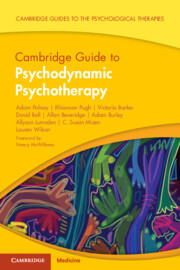Book contents
- Cambridge Guide to Psychodynamic Psychotherapy
- Cambridge Guides to the Psychological Therapies
- Reviews
- Cambridge Guide to Psychodynamic Psychotherapy
- Copyright page
- Dedication
- Contents
- Foreword
- Preface
- A Note from the Series Editor
- Acknowledgements
- Part 1: An Overview of the Model
- Part 2: The Model of Psychodynamic Psychotherapy into Practice
- Chapter 5 Framing a Psychodynamic Space
- Chapter 6 The Goals of Psychodynamic Psychotherapy
- Chapter 7 Psychodynamic Psychotherapy Technique
- Chapter 8 The Overall Structure of Psychodynamic Therapy
- Chapter 9 Psychological Assessment and Formulation in Psychodynamic Psychotherapy
- Chapter 10 Some Reflections on the Supervisory Process
- Part 3: Application for Mental Health Presentations
- Part 4: Application of Psychodynamic Psychotherapy in Different Populations and in Different Settings
- Glossary of Terms
- Index
- References
Chapter 6 - The Goals of Psychodynamic Psychotherapy
from Part 2: - The Model of Psychodynamic Psychotherapy into Practice
Published online by Cambridge University Press: 25 August 2023
- Cambridge Guide to Psychodynamic Psychotherapy
- Cambridge Guides to the Psychological Therapies
- Reviews
- Cambridge Guide to Psychodynamic Psychotherapy
- Copyright page
- Dedication
- Contents
- Foreword
- Preface
- A Note from the Series Editor
- Acknowledgements
- Part 1: An Overview of the Model
- Part 2: The Model of Psychodynamic Psychotherapy into Practice
- Chapter 5 Framing a Psychodynamic Space
- Chapter 6 The Goals of Psychodynamic Psychotherapy
- Chapter 7 Psychodynamic Psychotherapy Technique
- Chapter 8 The Overall Structure of Psychodynamic Therapy
- Chapter 9 Psychological Assessment and Formulation in Psychodynamic Psychotherapy
- Chapter 10 Some Reflections on the Supervisory Process
- Part 3: Application for Mental Health Presentations
- Part 4: Application of Psychodynamic Psychotherapy in Different Populations and in Different Settings
- Glossary of Terms
- Index
- References
Summary
This chapter commences with a brief description of the complexities conceptualising goals in psychodynamic psychotherapy as they differ across different schools. In addition, some goals are inferred rather than being explicit. Nonetheless, the author goes on to delineate goals which are relevant to early, middle, and end stages of a course of psychodynamic therapy. These include promotion of a positive alliance, a description of ‘common factors’ in therapy, and also some relevant technical goals. Final stage goals consist of management of the ending and enabling the ability to mourn the lost good object of the therapist. An alternative framework to conceptualising goals is presented in terms of symptom relief, life adjustment, personality change, and use of relevant procedures as being necessary. Clinical vignettes are used to illustrate these concepts. Finally, there is a brief section on current contributions from neuroscience specifically related to psychodynamic psychotherapy.
Keywords
- Type
- Chapter
- Information
- Cambridge Guide to Psychodynamic Psychotherapy , pp. 89 - 97Publisher: Cambridge University PressPrint publication year: 2023



